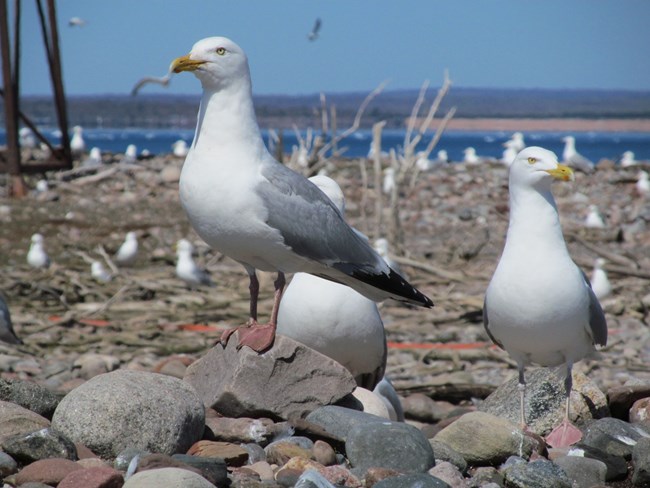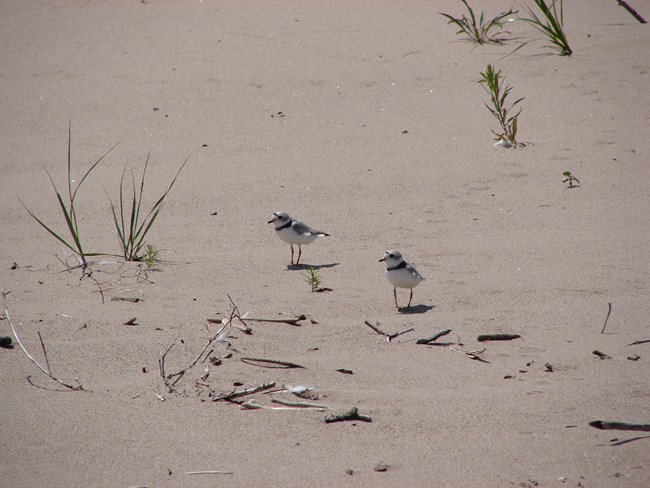
NPS Photo General Information About BirdsBring your binoculars and keen sense of hearing to observe a variety of birds throughout the islands. With its strategic geographic location, The Apostle Islands has a large diversity of habitats and refuges for birds. These islands were identified in the 1950s and 1960s as one of the heaviest traveled migratory flyways in the Great Lakes Region. The islands reduce the distance birds fly over open water when migrating to areas north of Lake Superior. Outer and Long Island provide critical habitats for migratory birds such as passerines, hawks, falcons, waterfowl, and shorebirds in the spring. Birds can find habitat on nearly all other islands in the park. There are large fluctuations in migratory volume from year to year, especially on Outer Island, most likely due to highly variable weather conditions. 
NPS Photo 
NPS Photo Avian Research in the ParkGull and Eagle Islands combined have 88% of the lakeshore's breeding herring gull populations and 80% of the herring gull breeding population on the entire Wisconsin shore of Lake Superior. Eagle Island has the only great blue heron rookery in the park. Every year park staff conduct breeding bird surveys for herring gulls and cormorants on Gull Island. Breeding birds surveys take place every year (1990-present), in partnership with Great Lakes Inventory & Monitoring Network. Piping plover/Mashkodeng/Charadrius melodus – Federal, Tribal, and State endangeredResource stewardship of piping plover is a collaborative effort between the park, Bad River Band, Wisconsin Department of Natural Resources (WDNR), U.S. Fish and Wildlife Service (FWS), University of Minnesota (UM) and The Nature Conservancy (TNC). Long Island and the Michigan sandspit were designated as critical habitat for piping plover by the U.S. Fish and Wildlife Service in 2001. Long Island is the most important piping plover habitat in the park and, until 2019 was its only successful nesting location. It was also the only successful plover nesting location in Wisconsin until 2016. From 2006 to 2020 the number of successful nests has ranged from 3-5 and the number of successfully fledged chicks from 5-15. High Lake Superior water levels and intense storms in recent years have degraded and reduced habitat availability on Long Island, resulting in fewer nests and lower success rates. There has been rare, but occasional nesting on Outer, Stockton and Michigan Islands. Successful nesting occurred on the Outer Islands sandspit in 2019 and 2020. Stockton Island, Julian Bay, had successful nesting in 2019 and the Michigan Island sandspit had its first successful nesting in 2020. Since 2007, there have been plover monitors stationed on Long Island to monitor plover nesting, provide information to visitors and make observations. The Bad River Natural Resource staff has led the plover monitor program on Long Island since 2010, with assistance and collaboration from park staff and other partners. Park staff check other island locations annually with the assistance of WDNR and monitor nests, as needed. Other important partners include FWS, Ecological Services, UM and TNC. 
NPS Photo Success StoryThe bald eagle/Migizi/Haliaeetus leucocephalus, an Ojibwe clan animal, has been a success story in the islands as it has throughout the country, although concerns with contaminants remain (Dykstra, et. al 2019). In the 1970’s, eagles were on the brink of extinction throughout the country and absent from the Apostle Islands. Following legal protections and banning of DDT, bald eagle numbers started to recover. Eagles returned to the Apostle Islands in 1980, with the first successfully fledged young in 1983. Nesting gradually increased until 2009, then increased more rapidly. By 2018, there were 46 active eagle nests on 21 of the 22 Apostle Islands, all except three-acre Gull Island. Bald eagle monitoring (1980-2018) – WDNR overflights and banding significantly scaled back after delisting of endangered species and the end of the Great Lakes Inventory & Monitoring Network led bald eagle and contaminants research. The Chequamegon Bay Bird ChecklistThe Chequamegon Bay area is among the best birding locations in Wisconsin. Situated along the south shore of Lake Superior, the bay is a unique landscape feature that forms a central point for a diversity of habitats including open water, mudflats, coastal wetlands, open fields, pine barrens, and varied forest types. As a result, the bay area hosts a wide variety of bird species that depend on these habitats during the breeding, migration, and winter seasons. Abundant public lands and extraordinary natural beauty provide visitors with unparalleled bird watching opportunities in this area of northern Wisconsin. This checklist below includes more than 300 bird species observed at least once in the Chequamegon Bay area since 1972. The list applies to areas of Ashland, Bayfield, and Iron Counties within a 40-mile radius of the city of Ashland, Wisconsin, and includes species observed by or reported to the authors. Select a Park:Select a Species Category (optional):
Search results will be displayed here.
Birds |
Last updated: January 16, 2024
